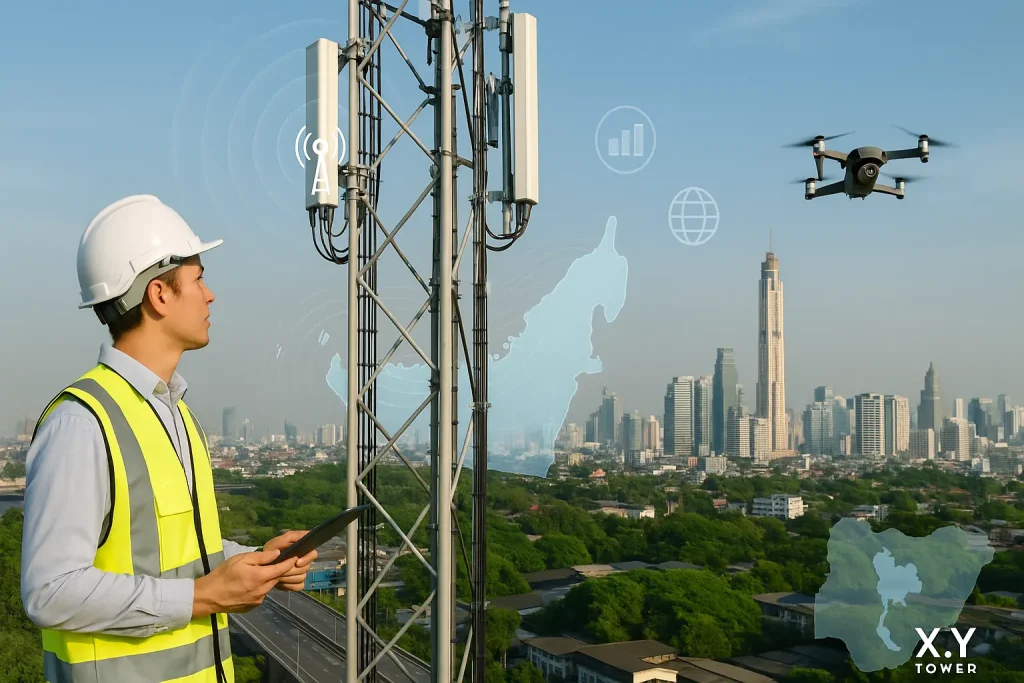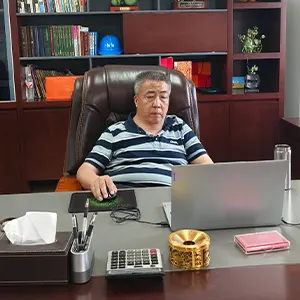Telecommunication Tower Infrastructure in Thailand
2025-09-25
A communication tower in Thailand is a vital component of the nation's digital infrastructure. Thailand is a major economic hub in Southeast Asia. It has a vibrant digital economy and a world-class tourism industry. Both sectors depend on seamless and high-speed mobile connectivity. The country’s diverse geography, from mountainous north to southern islands, presents unique challenges. Infrastructure partners must deliver resilient towers and sophisticated deployment services. A leading supplier understands these specific conditions. They provide the essential foundation for one of the region’s most advanced 5G networks. This guide examines the dynamic market for telecom towers in Thailand.

Key Drivers for Tower Infrastructure Growth in Thailand
The demand for a communication tower in Thailand is propelled by strong and sustained growth drivers. The nation is at the forefront of technological adoption in the region. This is supported by a clear government vision and intense competition among service providers. These factors ensure continuous investment in the country's telecom network. Understanding these drivers is essential to grasping the opportunities within the Thai tower market. They explain the ongoing need for network densification and technological upgrades.
The Aggressive Nationwide 5G Rollout
Thailand was one of the first countries in Southeast Asia to launch commercial 5G services. This early and aggressive rollout is a primary driver for the market. 5G technology requires a much denser network of sites than previous generations. A communication tower in Thailand must be ready to host advanced 5G antennas. This often involves building new towers or structurally reinforcing existing ones. This rapid technological shift is fueling a major cycle of infrastructure investment across the country.
The "Thailand 4.0" Economic Model
The government's "Thailand 4.0" initiative is another key driver. This economic model aims to transform the country into a value-based, innovation-driven economy. It focuses on developing high-tech industries, smart cities, and a digital society. All of these goals are dependent on world-class connectivity. A reliable communication tower in Thailand is a fundamental enabler of this national vision. It provides the essential infrastructure for IoT, AI, and other advanced digital services.
High Data Demand from Locals and Tourists
Thailand has a digitally active population that consumes a large amount of mobile data. Streaming video, e-commerce, and social media are deeply integrated into daily life. In addition, the country welcomes millions of international tourists each year. These visitors also have high expectations for mobile connectivity. This dual demand from both locals and tourists creates a massive and constant strain on network capacity. A communication tower in Thailand is crucial for meeting these high capacity demands.
Operational Challenges in the Thai Market
Deploying a communication tower in Thailand involves navigating a specific set of operational challenges. The country's tropical climate, varied geography, and developed urban centers create a complex environment. A successful infrastructure provider must have the expertise to manage these issues. These challenges impact all stages of a project, from site acquisition and engineering to long-term maintenance. Overcoming these hurdles is a key differentiator for leading tower companies.
Engineering for a Tropical Monsoon Climate
Thailand has a tropical monsoon climate. This is characterized by high heat, intense humidity, and a distinct rainy season with potential flooding. A communication tower in Thailand must be designed to withstand these harsh conditions. This requires superior corrosion protection, such as high-quality galvanization and specialized coatings. Designs must also account for heavy wind loads during tropical storms. The durability and resilience of the structure are critical engineering considerations. This is a common challenge in the broader market for telecom towers Asia-Pacific.
Logistical Complexities of Diverse Terrain
The geography of Thailand is diverse. It includes the mountainous regions of the north, the central plains, and the long southern peninsula with many islands. Transporting tower components to a remote mountain site or an island resort presents significant logistical challenges. Road access can be limited. It often requires a combination of land and sea transport. A leading provider of a communication tower in Thailand must have a sophisticated logistics network. They need to be able to manage these complex supply chains efficiently.
Navigating the Regulatory Framework
The telecommunications industry in Thailand is overseen by the National Broadcasting and Telecommunications Commission (NBTC). The NBTC sets the technical standards and manages spectrum licensing. In addition to national regulations, there are also local municipal rules for construction permits and zoning. An experienced provider of a communication tower in Thailand has a deep understanding of this regulatory landscape. They can navigate the permitting process effectively to avoid project delays.
Aesthetic Concerns in Tourist and Historic Areas
Thailand has many areas of great natural beauty and cultural significance. There is a strong focus on preserving the aesthetic appeal of these locations. This is particularly true in major tourist destinations and historic city centers. A standard lattice tower may not be acceptable in these sensitive areas. A provider of a communication tower in Thailand must offer a range of aesthetic and camouflaged solutions. This includes slim monopoles and structures disguised as natural features like trees. This is a similar requirement for a cell tower supplier Philippines, another tourism-focused nation.
The Structure of the Thai Communication Tower Market
The market for a communication tower in Thailand is mature and highly competitive. It is characterized by the significant role of independent tower companies. These towercos own and manage a large portion of the country's passive telecom infrastructure. This market structure promotes efficiency and rapid network deployment. Understanding the roles of the key players is essential for anyone participating in this dynamic industry.
The Key Role of Independent Towercos
Independent tower companies are a central feature of the Thai market. They own large portfolios of towers and enter into long-term lease agreements with mobile operators. This tower-sharing model is the industry standard. It allows operators to expand their 5G networks with greater speed and lower capital investment. These towercos are the primary customers for companies that manufacture and install a communication tower in Thailand. Their investment plans are a major indicator of market direction. This model is very similar to the successful business of cell tower leasing Indonesia.
The Intense Competition Among MNOs
The mobile market in Thailand is intensely competitive. The major mobile network operators (MNOs) are in a constant battle for subscribers. They compete aggressively on network quality, especially 5G coverage and speed. This competition is a primary driver of demand for new tower infrastructure. The network rollout strategies of these mobile network operators determine the need for a new communication tower in Thailand. They are the ultimate tenants and the source of revenue for the towercos.
The Ecosystem of Suppliers and Partners
A diverse ecosystem of companies supports the tower industry. This includes global manufacturers who supply the advanced steel structures and antenna systems. They bring international quality standards and the latest technology. These international firms frequently collaborate with local Thai construction and engineering partners. These local companies provide essential on-the-ground expertise and manage the civil works. A leading provider of a communication tower in Thailand often manages this entire supply chain. This is a common practice in other advanced regional markets like the market for a communication tower Malaysia.
A Strong Focus on Infrastructure Sharing
The Thai telecom industry has a strong focus on infrastructure sharing. This is seen as the most efficient way to achieve rapid nationwide 5G coverage. This goes beyond just sharing tower space. There are also arrangements for sharing active equipment and fiber networks. This collaborative approach helps to reduce costs and speed up deployment. A provider of a communication tower in Thailand must design structures that are optimized for multi-tenancy. This supports the industry's drive for efficiency.
Technological Innovations and Future Trends
The technology related to a communication tower in Thailand is constantly evolving. Innovation is driven by the advanced demands of 5G, a national push for sustainability, and the needs of smart cities. A leading provider must be an innovator. They need to offer solutions that are resilient, efficient, and technologically advanced. These trends are defining the next generation of telecom infrastructure in Thailand.
Sophisticated 5G Antenna Hosting
The nationwide 5G network in Thailand uses multiple spectrum bands. This requires towers that can host a variety of complex and heavy antenna systems. A communication tower in Thailand must be engineered to support these multi-band 5G deployments. This includes providing sufficient space and load capacity for Massive MIMO antennas. Providers must offer sophisticated mounting solutions and reinforcement services for existing towers. This level of technical expertise is a key requirement. A similar need for 5G readiness is seen with a telecommunications tower Vietnam.
The Growing Demand for Green Power Solutions
There is a growing emphasis on sustainability and reducing the carbon footprint of the telecom industry. This is in line with Thailand's national goals for clean energy. A leading provider of a communication tower in Thailand offers integrated green power solutions. This is particularly important for sites that are not connected to a reliable power grid. These systems reduce reliance on diesel generators, lowering both costs and emissions.
The Deployment of Smart Poles and Urban Solutions
As 5G networks become denser, especially in cities like Bangkok, there is a need for more discreet infrastructure. The deployment of "smart poles" is a major trend. These are multi-functional structures that can host 5G small cells. A provider of a communication tower in Thailand is now also a provider of these smart urban solutions. These smart poles offer various integrated features:
- 5G/4G Small Cell Hosting: Providing network coverage and capacity.
- Public Wi-Fi Access: Offering internet connectivity in public spaces.
- LED Street Lighting: Energy-efficient lighting for the city.
- Surveillance Cameras: Enhancing public safety and security.
- Environmental Sensors: Monitoring air quality and other data.
Use of AI and IoT for Tower Management
Managing a large portfolio of towers requires advanced tools. There is a growing trend towards using Artificial Intelligence (AI) and the Internet of Things (IoT) for tower management. A smart communication tower in Thailand can be equipped with sensors. These sensors monitor structural health, power systems, and site security. AI-powered analytics can then predict maintenance needs before a problem occurs. This improves network uptime and operational efficiency. This is a key part of the digital transformation of infrastructure management. The logistical challenges in the market for a communication tower Indonesia also drive the adoption of such technologies.
Conclusion
The market for a communication tower in Thailand is one of the most advanced and dynamic in Southeast Asia. It is driven by the country's leadership in 5G deployment and its strong digital economy. The industry faces specific challenges related to its tropical climate and diverse geography. It is characterized by an efficient, towerco-led model and intense competition among operators. The future will be defined by further 5G densification and the adoption of smart, sustainable technologies. A leading provider of a communication tower in Thailand must be an expert in advanced engineering, complex logistics, and regulatory compliance. They are essential partners in building the world-class digital infrastructure that powers Thailand's future.

Hey, I’m Chunjian Shu
"X.Y. Tower: Reliable, innovative solutions for high-quality towers and electrical equipment with professional service.
